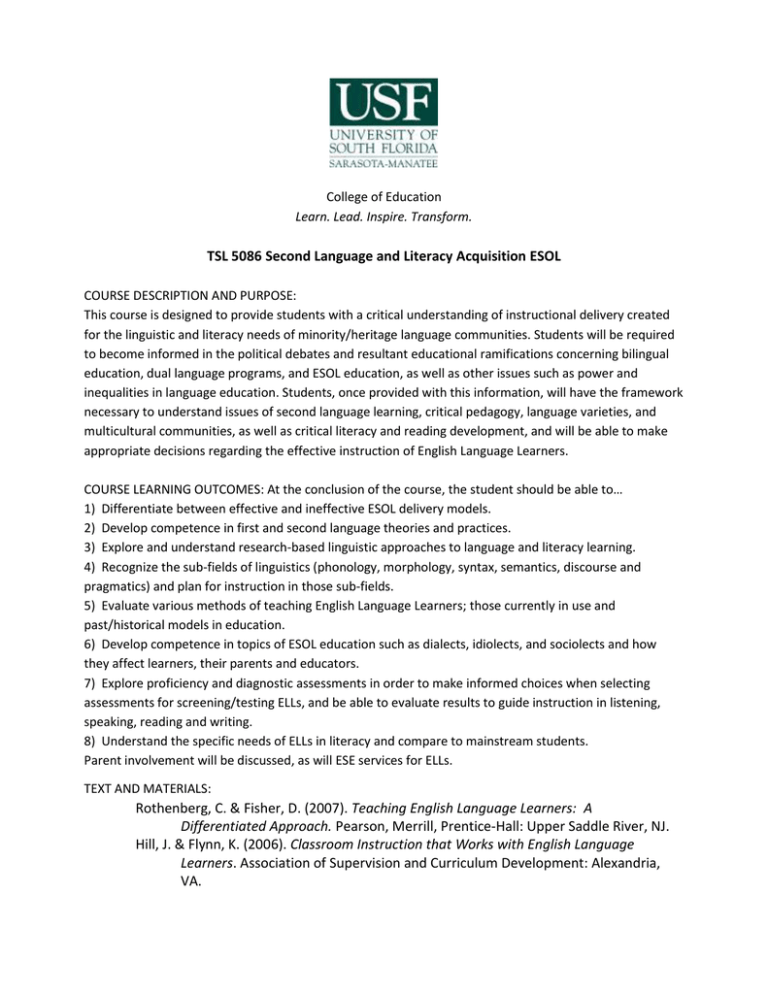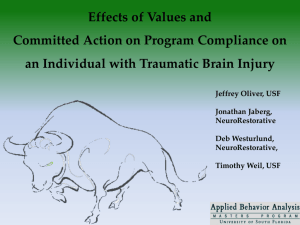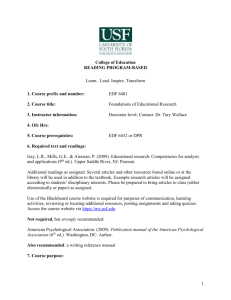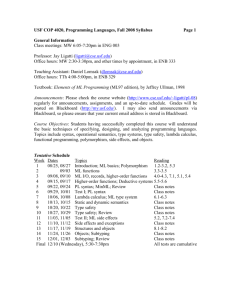TSL 5086 Case Study - USF Sarasota
advertisement

College of Education Learn. Lead. Inspire. Transform. TSL 5086 Second Language and Literacy Acquisition ESOL COURSE DESCRIPTION AND PURPOSE: This course is designed to provide students with a critical understanding of instructional delivery created for the linguistic and literacy needs of minority/heritage language communities. Students will be required to become informed in the political debates and resultant educational ramifications concerning bilingual education, dual language programs, and ESOL education, as well as other issues such as power and inequalities in language education. Students, once provided with this information, will have the framework necessary to understand issues of second language learning, critical pedagogy, language varieties, and multicultural communities, as well as critical literacy and reading development, and will be able to make appropriate decisions regarding the effective instruction of English Language Learners. COURSE LEARNING OUTCOMES: At the conclusion of the course, the student should be able to… 1) Differentiate between effective and ineffective ESOL delivery models. 2) Develop competence in first and second language theories and practices. 3) Explore and understand research-based linguistic approaches to language and literacy learning. 4) Recognize the sub-fields of linguistics (phonology, morphology, syntax, semantics, discourse and pragmatics) and plan for instruction in those sub-fields. 5) Evaluate various methods of teaching English Language Learners; those currently in use and past/historical models in education. 6) Develop competence in topics of ESOL education such as dialects, idiolects, and sociolects and how they affect learners, their parents and educators. 7) Explore proficiency and diagnostic assessments in order to make informed choices when selecting assessments for screening/testing ELLs, and be able to evaluate results to guide instruction in listening, speaking, reading and writing. 8) Understand the specific needs of ELLs in literacy and compare to mainstream students. Parent involvement will be discussed, as will ESE services for ELLs. TEXT AND MATERIALS: Rothenberg, C. & Fisher, D. (2007). Teaching English Language Learners: A Differentiated Approach. Pearson, Merrill, Prentice-Hall: Upper Saddle River, NJ. Hill, J. & Flynn, K. (2006). Classroom Instruction that Works with English Language Learners. Association of Supervision and Curriculum Development: Alexandria, VA. Eastern Stream Center On Resources and Training. (1998). Help! My Students Don’t Speak English: A resource guide for educators of limited English proficient migrant students Grades Pre-K-6. Free download. http://www.edvantia.org/products/pdf/HelpKit.pdf TaskStream Account is required. A critical task must be uploaded to your electronic portfolio TaskStream: TaskStream is a web-based electronic portfolio required of all students in the College of Education (COE) programs. It provides a way to submit documents, called Critical Tasks to instructors for feedback and assessment. The COE uses these assessments to evaluate candidate progress toward meeting standards set by the Florida Department of Education, the faculty and professional organizations. Further, the COE analyzes data from the assessments and uses the data for program planning in order to ensure continuous improvement. Assignments designated as Critical Tasks must be uploaded to your electronic portfolio on TaskStream and be rated with a mean score of 3 or higher in order for you to pass the course. Remember, failure to upload the Critical Task may result in a failing grade. In this course the critical tasks are: Case Study Recommended Texts: Ariza, E. et al. (2006). Why TESOL? Theories & issues in teaching English to speakers of other languages in K-12 classrooms. Dubuque, IA: Kendall-Hunt Publishers. Lems, K., Miller, L., & Soto, T. (2010) Teaching reading to English language learners: Insights from linguistics. NY: Guilford Press B. Required Materials and Resources: Daily, reliable internet connection: high speed service is strongly recommended Active USF NetID for Blackboard and USF e-mail access Authorization to download accessory software to your computer: e.g. QuickTime, Audacity, Skype, Jing, MSOffice 2007 Read-Only, etc. Microphone & speakers (built-in to your computer or headset) to view multimedia and to access interactive software. Headsets are available for checkout from the Distance Learning Help Desk. Portable audio recorder to create digital audio files (this equipment is available for student check-out from the Distance Learning Help Desk on the 2nd floor InfoCommons area. Transcribing equipment is also available for check-out. Access to scanning documents (USFSM Copy Center offers this service) Proficiency in navigating Blackboard, uploading & downloading documents, opening and saving documents, advanced word processing skills (headers, footers, pagination, numbering, fonts, margins, paragraph formatting, tables, etc.) Technical support USF Help Desk access: 1-866-974-1222; USFSM Distance Learning Team: ddrees@sar.usf.edu USFSM College of Education Curriculum Lab: B342 In partnership with the USF Library System, the USFSM College of Education houses a multi-media collection of curriculum materials which are available for check-out to students and faculty. The collection includes state adopted texts and teacher‘s guides; children‘s literature; hands-on materials for math, science, social studies, language arts and professional development texts in all the subfields of education. GRADING, EVALUATION AND ATTENDANCE POLICIES: Final Course Grade is based on graded assignments weighted as: A. Homework & Quizzes 40% B. Midterm Exam (Oral Interview) 20% C. Field Notes 20% D. Critical Task: Case Study*(20 hours) 20% *This is a Critical Task and must meet a College of Education minimum standard of Satisfactory to successfully pass the course. A grade of D is assigned for the course if a candidate‘s Case Study is rated as Unsatisfactory—regardless of the overall performance in the course. A grade of D or F in any course in the Teacher candidate‘s program will prevent placement in an Internship. C. Grading Scale: Plus and minus grading will be used for the final weighted percentage points as follows: A 93.50 and above A– 90.00–93.49 B+ 86.50–89.49 B 83.50–86.49 B– 80.00–83.49 C+ 76.50–79.49 C 73.50–76.49 C– 70.00–73.49 D+ 66.50–69.99 D 63.50–66.49 D– 60.00–63.49 F 59.99 and below Note: A final course grade of ―C minus‖ or lower will not be counted toward completion of a USF graduate program. Incomplete grades are ONLY available to students if the following conditions are true at the time of request: 75% of the course requirements have been met. All course requirements that have been met have received a passing grade. The student has a documented reason for being unable to complete the course requirements. Late work is accepted in this course if candidate has requested additional time for good reason. Timesensitive assignments on Discussion Board or Group Activities will not be awarded points past the stated deadline. No materials obtained from this course may be sold. COURSE SCHEDULE of Major Assignments: All assignments are detailed in the Assignments Folder on Blackboard. Additional Reading and Homework assignments are posted on Blackboard. This schedule is a planning guide; dates may be adjusted as needed. First Class Meeting: Overview of Course Resubmit Lesson Plan with ESOL Accommodations (ESOL I) Field Experience Plan Due Second Class Meeting First Field Post Due First SOLOM, Writing Sample Analysis, Running Record due Third Class Meeting L1 Alphabet Poster with Audio Due Second Field Post Due Fourth Class Meeting Oral Reading Fluency Scoring Rubric Due Mid-term Exam (oral interview by phone or in person) (March 7-11 Spring Break for Sarasota and Manatee County Schools) Fifth Class Meeting Third Field Post Due Second SOLOM, Writing Sample Analysis, Running Record due Sixth Class Meeting Last day to withdraw from the course without academic penalty. Seventh Class Meeting Fourth Field Post Due Final SOLOM, Writing Sample Analysis, Running Record due Fifth Field Post Due Signed Time Log with 20 hours completed due Case Study due Last day Instructor can submit final grades to USF Registrar Guidelines for All Written Assignments 1. E-mail correspondence, postings to Discussion Board, Blogs, and other written formats are viewed as a reflection of your professionalism even in these informal contexts. Therefore it is important to proofread even the most casual forms of communication before submitting. 2. Before submitting formal written assignments, review your writing (best with another person), revise, and edit before submitting. A first draft is not a completed assignment. Use writing resources: planning guides, grammar guides, editing guides, and The USFSM Writing Resource Center http://www.sarasota.usf.edu/Academics/CAS/WritingCtr.php The Writing Resource Center can work with students at any time, on line or in person, and on any stage of a written assignment. What better way to learn the art of coaching writing than to be coached by experts? Try it; you‘ll like it. 3. The College of Education follows the style requirements of the American Psychological Association (APA Publication Manual, 6th Edition) for formal writing assignments. Many quick reference guides to APA format are posted on-line. The following are the most basic APA format standards you must follow: Use Times New Roman, 12-point font. Double-space all text. Use 1-inch margins for top, bottom, and sides. Use the page header to put the first two or three words of the title and a page number on every page, upper right hand corner. Cite sources of information generously, including classmates as sources, using the author-date method of in-text citation. Use headings to identify distinct sections of the text. Provide complete references at the end of the document. 4. Use the page footer to put your name on every page. (This is not consistent with APA formatting, but it is necessary to keep track of students‘ work coming from the printer.) 5. Save your work. If your submission is lost or damaged, it is your responsibility to replace it. 6. Technical writing: To refer to units of language, use italics or double quotes for the word itself and single quotation marks for a gloss: e.g. The Spanish word embarazada means ‘pregnant‘. Also, single quotation marks are used to embrace single characters, while double quotation marks enclose whole words or phrases: The letter 'o' is one of the most used in the English language. The word ―plagiarism‖ refers to use of the words or ideas of another person without citing the source of the material. 7. When using symbols to represent sounds, put the symbol between forward slash marks: /ŋ/. Case Study: Case Study The complete Case Study assignment is available on Blackboard. This list is intended to give an overview of the number, scope, and depth of the technical components of the Case Study. 1. Field Posts (Discussion Board): Each Original Field Post will address an assigned topic in addition to a general account of your work with your case study student(s): what your objectives were, what you planned, the outcome, and your reflection. Field Post assigned topics will be given in the Blackboard Assignments Menu. Each Original Field Post must be a minimum of 300 words in length and must meet the Guidelines for All Written Assignments. Guidelines for Response Posts will be given in the Blackboard Assignments Menu along with the assigned topic. 2. Three Student (Academic) Oral Language Observation Matrix reports are to be submitted with digital files of audio recording. (Note audio recorders available for check- out at InfoCommons Distance Learning Desk.). Examples and rationale must be provided for each rating and the overall score discussed. 3. Three writing sample analyses are to be submitted with scanned copy of the student‘s writing with the name blacked out. (Scanning services are available at USFSM Copy Center and InfoCommons). Writing Sample Analysis includes the following: Guide to Analysis of Student‘s Written Language Objective of Writing What is the purpose and motive for this piece of writing? Who is the writer‘s intended audience? In what stage of the writing process is this piece? Under what circumstances did the student write this piece? Why is this piece chosen for analysis? Pragmatics Interpret the Big Idea of the student‘s writing; deal with the physical presentation of text (smudgy, tiny, hard to read, etc.). Discourse: List each of the idea units expressed in the student‘s writing. Identify each connector the student used (and, but, when, after, etc.). Feedback to Student Semantics: Map each the content words the student used. Syntax: Inventory the subject NP and the predicate VP of each sentence. Morphology: :Inventory of inflections, compound words, and derivational affixes Phonology: Review spelling patterns for evidence of phonemic knowledge of English. Instructional Notes to Self 4. Three running records are to be submitted with digital files of audio recording and commentary on student‘s comprehension of the passage. 5. A Home Language Alphabet Poster, created ideally with help from your case study student/s, is submitted as a photo image of the 17 x 22-inch poster including upper and lower case letters, a soundbased key word for each letter, and a hand-drawn image of each key word. In addition, audio files of you and your student reading the pronunciation of each letter and each key word is submitted. 6. An oral reading fluency scoring rubric is designed for assessing your students‘ rehearsed oral reading fluency normed for his or her proficiency level and home language. The Mid-Term Exam will be conducted as a one-on-one, approx.. 15 min. interview (in office or by phone) discussing topics and terminology covered in course readings, homework assignments, and discussion board postings. Interviewees may have texts and notes available but the interview is to proceed at a regular conversational tempo. Ten questions will be posed that cover the areas of second language acquisition, methods of ESOL instruction, and applications in your field experience. Anyone scoring lower than C will be re-interviewed until responses meet passing criteria. A Discusses at least 8 topics without direct support from instructor. Elaborates on at least 5 topics with connections to additional topics/concepts or personal observations. All contributions reflect accurate use of terminology and secure understanding of concepts. B Discusses at least 6 topics without direct support from instructor. Elaborates on at least 5 topics with connections to additional topics/concepts or personal observations. Most contributions reflect accurate use of terminology and concepts; interviewee can self-correct with light prompting. C Discusses at least 5 topics without direct support from instructor. Elaborates on at least 5 topics with connections to additional topics/concepts or personal observations. Most contributions reflect accurate use of terminology and concepts; interview may require direct support from instructor on up to 4 corrections. USFSM Policies Critical Tasks: Assignments designated as Critical Tasks must receive a passing grade in order to pass the course. If you turn in an assignment that receives an unsatisfactory grade, you will be required to redo the assignment. Your initial grade on the assignment will be used to compute your final grade for the course. The Critical Tasks(s) for this course is(are): TaskStream is a web-based electronic portfolio required of all students in College of Education (COE) programs. TaskStream enables students to build media-rich online portfolios showcasing learning achievements, which can be shared with peers, instructors, parents, and employers. Further, it provides a way to submit documents, called Critical Tasks, to instructors for feedback and assessment. The COE uses these assessments to evaluate candidate progress toward meeting standards set by the Florida Department of Education, by the faculty, and by professional organizations. Further, the COE analyzes data from the assessments and uses the data for program planning in order to ensure continuous improvement. Once your assignment is in your portfolio, it will be assessed using a rubric. You must earn a score of “3” or better on the critical task. Essential Assignments: These are assignments that have been aligned with one or more FLDOE curriculum requirements, i.e., ESOL standards, Reading Competencies, or Florida Teacher Competencies/Skills. USFSM Policies A. Web Portal Information: Every newly enrolled USF student receives an official USF e-mail account. Students receive official USF correspondence and Blackboard course information via that address. B. Academic Dishonesty: The University considers any form of plagiarism or cheating on exams, projects, or papers to be unacceptable behavior. Please be sure to review the university’s policy in the catalog, USFSM Undergraduate Catalog or USFSM Graduate Catalog and the USF Student Code of Conduct. Detection of Plagiarism http://www.cte.usf.edu/plagiarism/plag.html The University of South Florida has an account with an automated plagiarism detection service which allows instructors to submit student assignments to be checked for plagiarism. I reserve the right to 1) request that assignments be submitted to me as electronic files and 2) electronically submit assignments to SafeAssignment. Assignments are compared automatically with a huge database of journal articles, web articles, and previously submitted papers. The instructor receives a report showing exactly how a student's paper was plagiarized. For more information, go to http://www.ugs.usf.edu/catalogs/0304/adadap.htm#plagiarism. C. Academic Disruption: The University does not tolerate behavior that disrupts the learning process. The policy for addressing academic disruption is included with Academic Dishonesty in the catalog: USFSM Undergraduate Catalog or USFSM Graduate Catalog and the USF Student Code of Conduct. D. Contingency Plans: In the event of an emergency, it may be necessary for USFSM to suspend normal operations. During this time, USFSM may opt to continue delivery of instruction through methods that include but are not limited to: Blackboard, Elluminate, Skype, and email messaging and/or an alternate schedule. It’s the responsibility of the student to monitor Blackboard site for each class for course specific communication, and the main USFSM and College websites, emails, and MoBull messages for important general information. The USF hotline at 1 (800) 992-4231 is updated with pre-recorded information during an emergency. See the Safety Preparedness Website for further information. E. Disabilities Accommodation: Students are responsible for registering with the Office of Students with Disabilities Services (SDS) in order to receive academic accommodations. Reasonable notice must be given to the SDS office (typically 5 working days) for accommodations to be arranged. It is the responsibility of the student to provide each instructor with a copy of the official Memo of Accommodation. Contact Information: Pat Lakey, Coordinator, 941-359-4714, plakey@sar.usf.edu, www.sarasota.usf.edu/Students/Disability/ F. Fire Alarm Instructions: At the beginning of each semester please note the emergency exit maps posted in each classroom. These signs are marked with the primary evacuation route (red) and secondary evacuation route (orange) in case the building needs to be evacuated. See Emergency Evacuation Procedures. G. Religious Observances: USFSM recognizes the right of students and faculty to observe major religious holidays. Students who anticipate the necessity of being absent from class for a major religious observance must provide notice of the date(s) to the instructor, in writing, by the second week of classes. Instructors canceling class for a religious observance should have this stated in the syllabus with an appropriate alternative assignment. TSL 5086 Case Study Links to Standards: “Human Development and Learning,” “Learning Environments, “and “Technology” University of South Florida Sarasota-Manatee 1. Field Posts (Discussion Board): Each Original Field Post will address an assigned topic in addition to a general account of your work with your case study student(s): what your objectives were, what you planned, the outcome, and your reflection. Field Post assigned topics will be given in the Blackboard Assignments Menu. Each Original Field Post must be a minimum of 300 words in length and must meet the Guidelines for All Written Assignments. Guidelines for Response Posts will be given in the Blackboard Assignments Menu along with the assigned topic. 2. Three Student (Academic) Oral Language Observation Matrix reports are to be submitted with digital files of audio recording. (Note audio recorders available for check- out at InfoCommons Distance Learning Desk.). Examples and rationale must be provided for each rating and the overall score discussed. 3. Three writing sample analyses are to be submitted with scanned copy of the student‘s writing with the name blacked out. (Scanning services are available at USFSM Copy Center and InfoCommons). Writing Sample Analysis includes the following: Guide to Analysis of Student‘s Written Language 1. Objective of Writing What is the purpose and motive for this piece of writing? Who is the writer‘s intended audience? In what stage of the writing process is this piece? Under what circumstances did the student write this piece? Why is this piece chosen for analysis? 2. Pragmatics Interpret the Big Idea of the student‘s writing; deal with the physical presentation of text (smudgy, tiny, hard to read, etc.). 3. Discourse: List each of the idea units expressed in the student‘s writing. Identify each connector the student used (and, but, when, after, etc.). 4. Feedback to Student 5. Semantics: Map each the content words the student used. 6. Syntax: Inventory the subject NP and the predicate VP of each sentence. 7. Morphology: :Inventory of inflections, compound words, and derivational affixes 8. Phonology: Review spelling patterns for evidence of phonemic knowledge of English. 9. Instructional Notes to Self 4. Three running records are to be submitted with digital files of audio recording and commentary on student‘s comprehension of the passage. 5. A Home Language Alphabet Poster, created ideally with help from your case study student/s, is submitted as a photo image of the 17 x 22inch poster including upper and lower case letters, a sound-based key word for each letter, and a hand-drawn image of each key word. In addition, audio files of you and your student reading the pronunciation of each letter and each key word is submitted. 6. An oral reading fluency scoring rubric is designed for assessing your students‘ rehearsed oral reading fluency normed for his or her proficiency level and home language Semester: Student U-Number: Assessment Criteria – Assessment Students analyze ESOL pupil writing for elements related to pragmatics, discourse, morphology, phonology (spelling patterns), syntax, and grammar. Assessor: Level 1 Level 2 Level 3 Level 4 Level 5 Unacceptable Marginal Proficient Advanced Exceptional Score Assessment Criteria – Critical Thinking Level 1 Level 2 Level 3 Level 4 Level 5 Unacceptable Marginal Proficient Advanced Exceptional Level 1 Level 2 Level 3 Level 4 Level 5 Unacceptable Marginal Proficient Advanced Exceptional Score Students critically analyze, evaluate, and use higher order thinking abilities. Assessment Criteria – Diversity Score Student writing reflects an awareness and application of issues related to multilingual and multicultural diversity. Assessment Criteria – Human Development and Learning Students will collect data and provide an analysis of the data based on an understanding of human development and learning with a focus on literacy and second language development. Data collection and analysis reflect an in-depth understanding of how students develop second language and literacy in an academic environment, provide numerous relevant examples and support from course materials Level 1 Level 2 Level 3 Level 4 Level 5 Unacceptable Marginal Proficient Advanced Exceptional Score Assessment Criteria – Learning Environments Level 1 Level 2 Level 3 Level 4 Level 5 Unacceptable Marginal Proficient Advanced Exceptional Level 1 Level 2 Level 3 Level 4 Level 5 Unacceptable Marginal Proficient Advanced Exceptional Score Students will provide an analysis and solutions which reflect an understanding of the student‘s learning environments and their interaction with the student‘s cultural, academic and linguistic backgrounds. Analysis and solutions reflect an indepth understanding of the student‘s learning environments and their interaction with the student‘s cultural, academic and linguistic backgrounds, and provide numerous relevant examples and support from the course. Assessment Criteria – Technology Students will use of technology to organize and disseminate the case study. Technology used may include (but not be limited to) weblogs, podcasts, presentation programs, websites, or movies. Multiple types of technology were creatively combined to effectively organize and disseminate the case study in an engaging and polished manner. Score




